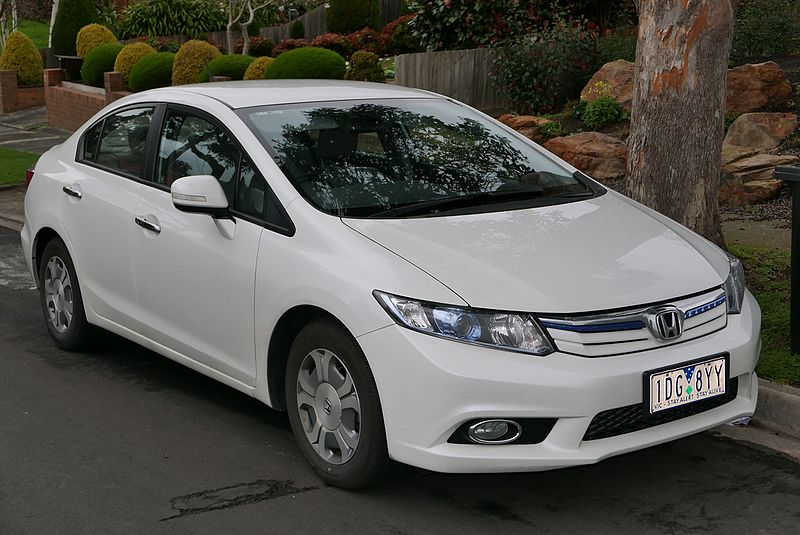
2014 Honda Civic Hybrid – Sedan
The Honda Civic Hybrid was a variation of the Honda Civic with a hybrid electric power-train. Honda introduced the Civic Hybrid in Japan in December 2001. In the United States, it was the first hybrid automobile to be certified as an Advanced Technology Partial Zero-Emissions Vehicle (AT-PZEV) from the California Air Resources Board (CARB).
The Civic Hybrid uses an Integrated Motor Assist hybrid system similar to that of the Honda Insight. The Civic Hybrid was only marketed in sedan configurations.
FIRST GENERATION (2001-2005)
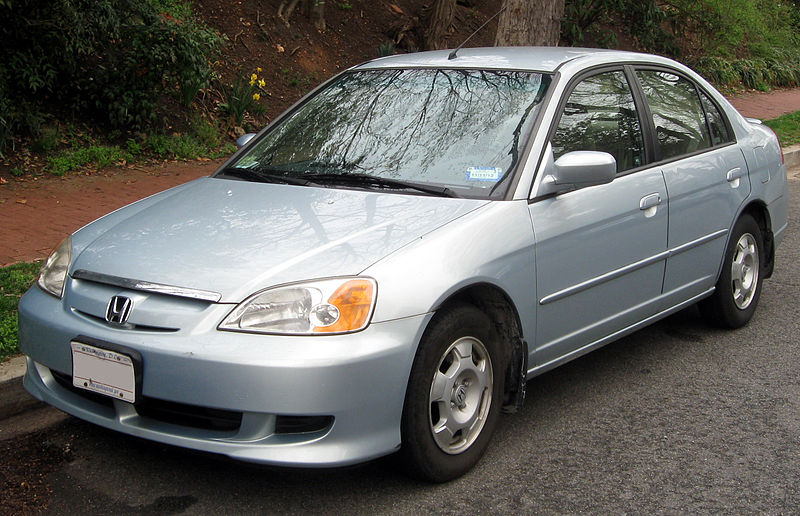
2003 Honda Civic Hybrid
The Civic hybrid, based on theseventh generation Civic, was first introduced to the Japanese market in December 2001. Honda claimed it was the most fuel efficient 5-passenger gasoline-powered production vehicle in the world at the time. It was introduced to the U.S. in spring 2002 as a 2003 model. It is the first hybrid vehicle to be certified as an Advanced Technology Partial Zero- Emissions Vehicle (AT-PZEV) from CARB.
Design
The first generation of the Honda Civic Hybrid was based on the seventh generation Honda Civic. It was the first mainstream vehicle from Honda equipped with a gasoline-electric hybrid system and became the second hybrid model of the company after Insight. Model with manual transmission was rated city 46 mpg‑US (5.1 L/100 km; 55 mpg‑imp) / highway 51 mpg‑US(4.6 L/100 km; 61 mpg‑imp) according to United States Environmental Protection Agency (EPA) fuel mileage estimates,[3] about the same combined mileage as for the Toyota Prius, and became the most fuel-efficient five-passenger sedan ever sold in North America at the time.[4]
The following is a list of its technical features:[5][6][7]
- Twin spark plugs light the lean fuel-air mixtures sent to the two-valve combustion chambers.
- 1.3-litre single overhead cam i-DSI lean-burn internal-combustion engine with VTEC Cylinder Cut-off System, which allows three cylinders to deactivate during deceleration. The engine generates 85 hp (63 kW) at 5,700 rpm and 87 lb·ft (118 N·m) of torque at 3300 rpm.
- Idle stop – when stopped at traffic light, the engine shuts off automatically, then restarts immediately when the driver takes their foot off the brake, contributing to both greater fuel efficiency and lower emissions.
- 10 kW (13 hp) brushless, permanent magnet assist motor, which functions as a generator during deceleration recharging the battery (regenerative braking).
- Combined output of both engine and electric motor is 93 hp (69 kW) at 5,700 rpm. Maximum torque is rated 116 lb·ft (157 N·m) at 1,500 rpm for manual transmission models and 105 lb·ft (142 N·m) at 3,000 rpm for CVT models.
- 144 V Nickel-metal hydride batteries with 6.0 A·h capacity.
- Honda Multimatic S continuously variable transmission or 5-speed manual transmission.
- ULEV or AT-PZEV certification by the California Air Resources Board (CARB).
- Low rolling resistance tires (P185/70R14) on aluminum wheels and regenerative braking.
- Electric power-steering.
Fuel economy
The Civic hybrid is estimated to be 40 percent more fuel efficient than its non-hybrid counterpart.
SECOND GENERATION (2006-2011)
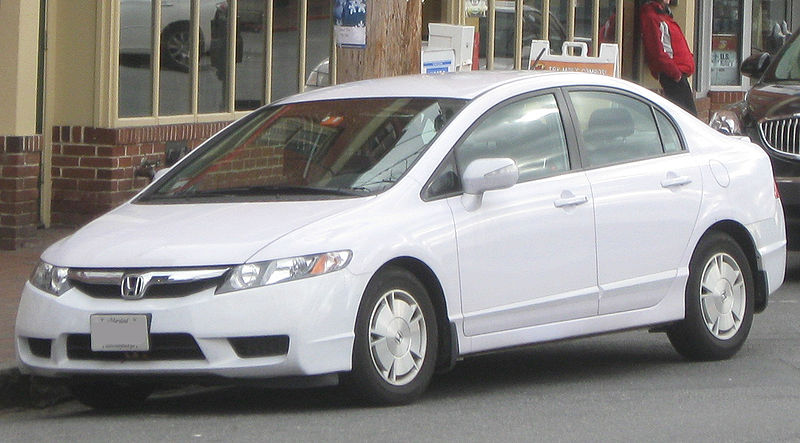
2009-2010 Honda Civic Hybrid – US model
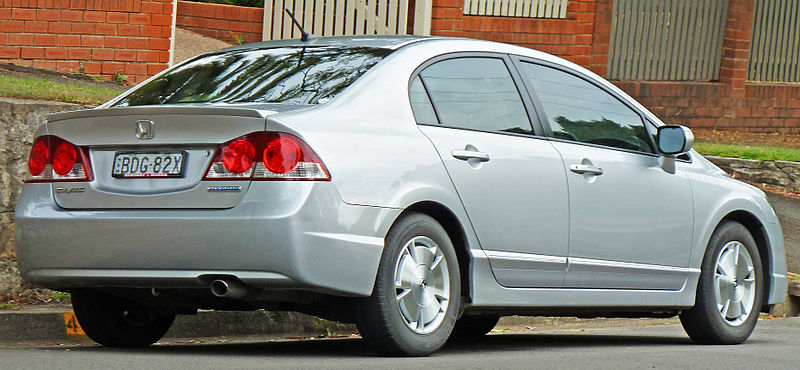
2006-2008 Honda Civic Hybrid – Asian model
The second generation Civic Hybrid is based on the eighth generation Civic. As with other Civics, there are some styling differences to the exterior between the North American and the Japanese market models.
Design
The power-train of the second generation Civic hybrid is similar to that of the first generation.
The following is a list of major changes:
- Updated to fourth generation Integrated Motor Assist (IMA)
- More powerful electric motor of 20 hp (15 kW)
- 158.4 V (132 x 1.2 V) Nickel-metal hydride batteries with 5.5 A·h capacity that is 12% smaller.
- Updated to three stage i-VTEC and VCM (Variable Cylinder Management), which permits deactivation of all four cylinders when cruising at moderate speed to run on electric power only. Engine output is increased to 93 hp (69 kW) at 6,000 rpm and maximum torque to 89 lb·ft (121 N·m) at 4,500 rpm.
- Combined output of both engine and motor is 110 hp (82 kW) at 6,000 rpm. Maximum torque is rated 123 lb·ft (167 N·m) at 2,500 rpm.
- A new hybrid compressor for the air-conditioner.
- The continuously variable transmission provides a 9% wider range between the maximum and minimum gear ratios for better acceleration and reduced engine rpm at high speeds.
- Discontinued manual transmission option.
- The U.S. EPA fuel economy estimate is increased to city 49 mpg‑US(4.8 L/100 km), highway 51 mpg‑US (4.6 L/100 km). (In 2008: EPA revised the way it estimates fuel mileage, as a result, the EPA rating for the 2008 model is: city 40 mpg‑US (5.9 L/100 km), highway 45 mpg‑US (5.2 L/100 km)).
- Updated to 15-inch lightweight aerodynamic alloy wheels (later featured on the Civic DX-G in Canada as well).
- Certified as AT-PZEV throughout 50 states.
Fuel economy
It is estimated that, when compared to a gasoline engine only Civic sedan of 2006 with an automatic transmission, the Civic hybrid provides an increase of fuel economy in city driving of about 63 percent and an increase of fuel economy in highway driving of about 27 percent.The CVT transmission is designed to achieve the highest efficiency for a given RPM.
A class-action lawsuit filed in 2012 alleged that Honda falsely advertised the fuel economy of the Civic Hybrid and that owners were getting significantly lower mileage. The Los Angeles Times reported in May 2012 that at least 36 small-claims lawsuits had also been filed against Honda over alleged false advertisement of gas mileage.
Some users reported that the fuel economy of the Civic Hybrid was reduced after Honda installed a software update to prolong the life of the hybrid battery by reducing the electric motor’s output and putting more reliance on the gasoline engine.
Battery Life
A Consumer Reports survey found a very high rate of battery failure in Civic Hybrids 2nd-generation Civic Hybrids, describing the failure rate for 2009-2010 models as “shocking”, with over 30% of responders reporting they had needed a battery replacement within the last 12 months. Honda acknowledged problems with the 2006-2008 models which could cause the batteries to “deteriorate and eventually fail”; software updates were issued to prolong the life of the battery, but some owners reported these updates led to reduced fuel economy and power. The 132 NiMH cell pack suffers from imbalance as individual cells can’t be monitored or charged. Monitoring is available at a 12 cell sub-pack level, but charging isn’t. After years/miles of use, the cells become imbalanced as the cells charge/discharge at slightly different rates from one another. Eventually, strong cells are limiting the upper capacity of the pack and weak cells are limiting the lower capacity of the pack thereby reducing the usable capacity of the pack. There are higher capacity non-OEM packs available for less than the OEM price, and many owners have achieved years-long extensions of usable battery life by utilizing a grid charger. A grid charger is a home-made or purchased charger that connects your car to the power-grid. These devices impart a long, slow “balancing” charge where all cells are gently charged to their maximum capacity. This can temporarily restore balance and dramatically improve usable capacity for months at a time.
In March 2015, Honda sent 2009-2011 owners a letter indicating that all versions, not just the PHEV states, would get the 10 year/150,000 mi warranty on the IMA battery.
THIRD GENERATION (2011-2015)
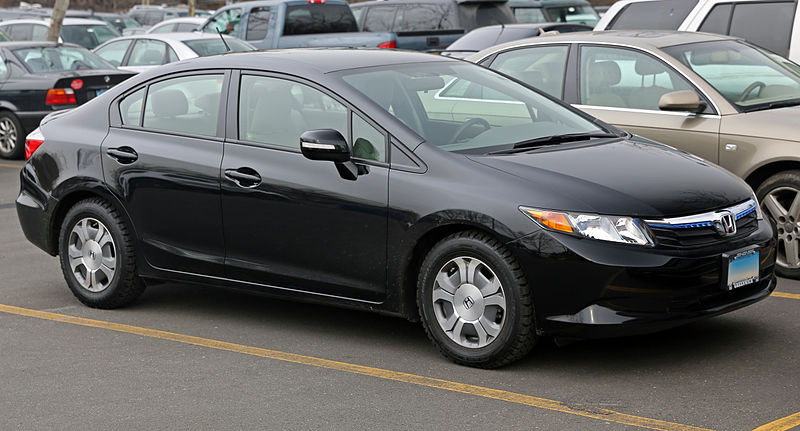
2012 Honda Civic Hybrid – US model
The last Civic Hybrid was launched during 2011 in the U.S. and Canada as a 2012 model. It has a larger 1.5-liter i-VTEC engine that produces 90 horsepower and 97 pound-feet of torque and a lithium-ion batterypack instead of nickel-metal hydride. The larger engine replaces the 1.3-L engine for better mid-range torque. The DC brushless permanent magnet motor, which is placed between the engine and continuously variable transmission, provides 17 kW (23 hp) and 78 pound-feet of torque and weighs 0.7 kg (1.5 lb) less. The 2012 Civic Hybrid has an EPA rating of 44 mpg‑US (5.3 L/100 km; 53 mpg‑imp) for the city and highway driving cycles, an improvement from 40 mpg‑US (5.9 L/100 km; 48 mpg‑imp) city and 43 mpg‑US (5.5 L/100 km; 52 mpg‑imp) highway for the previous generation.
The Civic Hybrid has the latest Integrated Motor Assist (IMA) parallel hybrid system, with a new 20 kW lithium-ion battery — a first for a Honda hybrid vehicle. The new battery is 5 kW more powerful, 9 kg (20 lb) lighter and takes up 36% less space.Battery capacity is increased from 35 kAh to 100 kAh (4.5 Ah).
It comes with improved aerodynamics and Honda ECO Assist technology. The ECO Assist technology is an information system to help the driver adopt a more fuel-efficient driving style, and is proven to improve fuel economy by about 10% for Honda’s hybrid vehicles in Japan.
Production
Production of the Civic hybrid sedan was moved from Suzuka, Japan to Indiana, United States in early 2013, following the production of the Acura ILX hybrid commenced at Indiana plant in April 2012, after production capacity was expanded to 250,000.
Sales
In February 2009, Honda reported that since 2001 they had sold more than 255,000 Civic Hybrids, including more than 190,000 units sold in North America.[41] For a time, the Civic Hybrid was the second-best-selling hybrid electric car in the U.S.[21]
| Cumulative sales by region (as of the end of January 2009)[41] | ||||||
|---|---|---|---|---|---|---|
| Region | Start of sales | Cumulative sales | ||||
| Japan | Dec 2001 | 22,899 | ||||
| North America | Mar 2002 | 191,493 | ||||
| Europe | May 2003 | 34,757 | ||||
| Asia/Oceania | Feb 2004 | 5,514 | ||||
| China | Nov 2007 | 280 | ||||
| Others | May 2006 | 306 | ||||
| Total | 255,249 | |||||
It is reported that over 50,000 Civic Hybrids were sold during 2007 worldwide.
SOURCE: wikipedia
